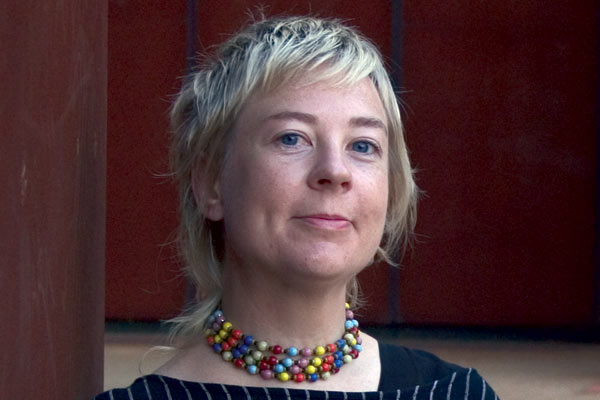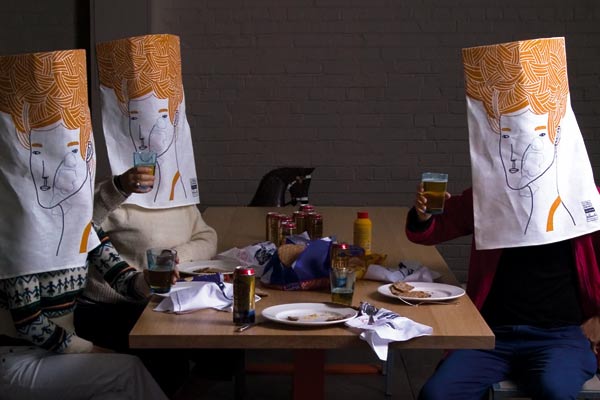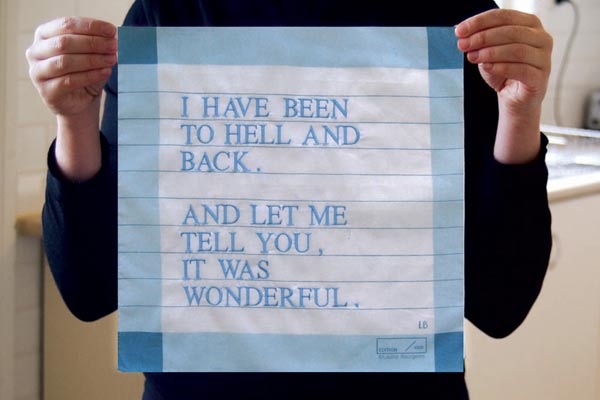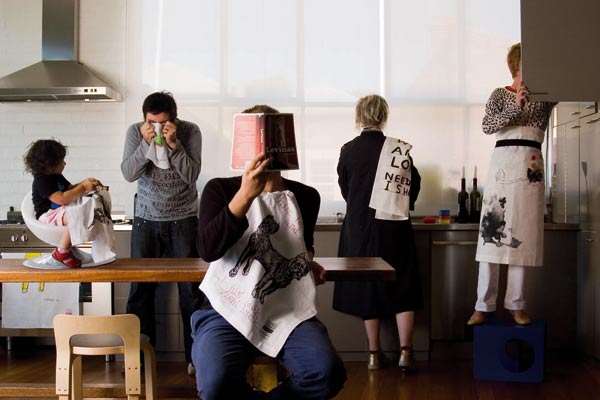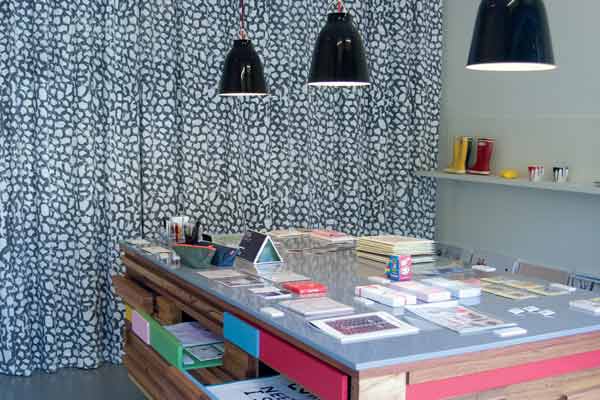Third Drawer Down: Abi Crompton
Melbourne-based Third Drawer Down is most commonly spoken about as ‘that tea towel company’ but in reality it is a whole lot more. In six years, director Abbie Crompton has expanded her business beyond limited edition tea towels and other products, to now include two other successful streams – an online store and retail space in Fitzroy, described as a ‘museum of art souvenirs’ and also a highly specialised agency that works exclusively with the retail arms of art and design museums around the world.
Abi spoke to the ADU about her vision for Third Drawer Down and how she has dealt with copycats and remained true to the values she set out at the beginning.
Business: Third Drawer Down (2003)
Type of business: Production and wholesale of limited edition products with international artists and designers through the Third Drawer Down project; boutique and online retailer; consultancy and agency that works with international art and design museums on the production of art souvenirs.
Location: Melbourne, Victoria, Australia
Principal: Abi Crompton, Founder and Director
Contact: www.thirddrawerdown.com
ADU: What was your goal when you first started – you have said it was about making art accessible, did it start as a casual thing, or did you ever imagine that it would grow to what it has?
Abi Crompton: The project part of my business was very much based around what pop art did in the sixties – making multiples of art objects in order to offer something to the public that was affordable and very much accessible. That was really the backbone of Third Drawer down and where it came from.
When I started it, one of the biggest questions that I had was whether I wanted Third Drawer Down to be part of tradition, or whether I wanted it to be part of a trend. I decided to take the tradition path. So it was always my focus to develop an agency and for it to be more than just a tea towel project but I suppose I did approach it by being part of tradition, that you need to repeat things over and over again for it to become a part of tradition. Because if it is a trend I would have done a tea towel for one or two seasons and then kind of ended that and made another product or project. I took the viewpoint I had to keep repeating it.
Why were tea towels chosen to be the product that would become a tradition?
I owe that to my dad. He had a textile importing business and he had 200 tea towels that he had dyed and they shrunk in the process due to the heat. So he gave those to me and said, ‘Do something with them.’ So coming from a fine art background I started to do appliqué and a whole lot of things on them and I got really bored after the third one.
But I liked the idea of the tea towel – that it was a functional object that was quite universal in its translation, that it was easy to export and the closest thing to an artists’ canvas. That’s also where the brand name came from – the third drawer down is predominantly where people keep their tea towels. But I never intended to do tea towels for the rest of my life – they were a stepping-stone or part of a whole.
It was never really about the object itself – it was about the principals behind it. So when I originally created Third Drawer Down, I created a list of things that on a philosophical level I meant the business to represent. I haven’t deviated from that – it has been the same ever since.
Did you see the project as something that you would be doing full-time one day?
Yes, very much so. I suppose in some ways the projects and the production of limited edition textiles and objects with artists and those sorts of things is more the indulgent part of my business. It is a way of me being able to meet amazing people from all around the world. The agency allows me to work with museums and artists of another caliber and in different directions. We do a lot of textiles in the agency but we make anything from soap bars through to kaleidoscopes to snowdomes to any kind of product – there is quite a diversity in the kind of products that we make.
Your background is in fine arts and psychology – did you work as an artist prior to starting the business?
After I did my fine arts degree I was going to be a practicing artist and I had set up a series of exhibitions and was all sort of ready to go down the ‘art path’. At that stage I was also working at a design bookstore and I went for a job at the National Gallery of Victoria and got the position as a product developer. That was my first experience within the museum field and also designing and developing objects for artists. After I left the NGV I moved to Craft Victoria and it was there that I took my experiences from the NGV and coming from a family background in retail, and a whole lot of stuff, to establish Third Drawer Down.
Many artists deal in singular items and that scarcity is what defines value, why was it important to you to be producing art in limited numbers and multiples and making that accessible to the public?
I suppose it comes from a semi-Socialist idea, allowing not a mass of people, but to allow a greater number of people the enjoyment, or to be a part of a moment in design or in art. I think very much it is about the collective and the collectable. We really try as much as possible to produce things that are accessible within a price range rather than producing a multiple of five at $5000 each producing a multiple of 500 and have them at $40.00 each. It is just a different type of equation that we like to work within.
Have any of your products incidentally ended up in that higher market due to demand – sold out and then resold for more money?
Yes, the products we did in collaboration with Tate Modern and Louise Bourgeois sold out after three days. They were released at the same time as the Frieze Art Fair was on, they sold out of the hanky after three days and because they were editioned pieces the after market through Ebay and other auction houses still exists.
I do find it fascinating, any type of industry that has an after market or potential of that, is really interesting. I think a lot of art and its pricing is an absurd equation anyway. Like you look at artists like Damien Hirst, he kind of uses the sense of the edition, even his books you can buy for 20 pounds or if you want it hand signed it costs 200 pounds.
You have collaborated with over eighty artists since you first start the Third Drawer Down project. Most artists deal in singular items – it must be quite a learning curve for some of them to get their head around the idea of producing multiples.
It is. That’s why when we choose artists to work with it is really about finding people that I not only admire but that are interested in that true sense of collaboration. Each time I learn as much about them and their work as they do about the systems and operations of consumer dynamics. It really is not just about having an artwork and putting it on a product. It’s also working out whether that piece is going to sell. I kind of wondered what I would be using my psychology degree for and I kind of find myself quite often being aware about those kinds of situations.
How many staff do you have?
I have six staff that work for me and they work across the board. I have an industrial designer and someone who specialises in the wholesale retail side of things. It it is a small team but we run across all the different areas and work across the three platforms. I think in a lot of ways it is better to have for the small studio environment. I like to have a smaller internal team and then depending on the project it can either grow or shrink depending what is happening at the time. We do freelance out specific projects and parts of projects, from public relations through to graphic design, if those things are required.
How much business experience did you have prior to starting Third Drawer Down?
I remember on my thirteenth birthday that I didn’t want to come home until I had a job. My family really instilled in me a strong work ethic because they have always had businesses in hospitality through to clothing stores. I always worked throughout my schooling in those types of industry. Again it was a really natural transgression.
Did you start doing everything by yourself?
I remember I used to sleep next to the boxes of my packaging and first thing I would think is ‘I have to sell those!’ I worked out of my home and packed everything myself, did everything myself. So I really started small. I started from me outwards.
Who were your first customers?
I launched the brand at Craft Victoria and it was really nice because the majority of my current customers in Australia all took Third Drawer Down on at the beginning. So I have had really long-term relationships with a lot of the stores that I work with. That’s been important because I believe that if you are going to do something eighteen hours a day, you need to like the people you work with and I kind of work with stores and people that are good people and that I like.
How many stockists would you now have locally and overseas?
We have less stockists than we used to. The core group do really well with Third Drawer Down product so I have made it slightly more exclusive than it used to be. I think in Australia we have fifteen or twenty stores that take on the Third Drawer Down project pieces. I wouldn’t know overseas – we have a nice healthy list of stores in museums around the world and all the major cities in the US. There’s a nice broad spectrum of people that we work with.
Since you started your business there have been a lot of people who have begun designing limited edition or artist designed tea towels in a similar vein to Third Drawer Down, how do you now manage your intellectual property or trade secrets?
It is an issue that I think designers need to be more aware of, to support and nurture other designers ventures instead of climbing into the passenger seat next to them and thinking they can go for the ride too. I have had some artists I have commissioned to work on projects, and then for example, their partners at that time were designers or launching a new range or whatever, and when I am going to launch their commissioned work their partner is launching practically the same thing.
I think perhaps working with artists that may be a problem because they might produce a very similar work again..
Which is fine and we like the idea that we support them by publishing the work and we don’t ever want copyright on their work but it is when they tell their friend or their partner they are working on something with us and then that friend or partner tries to piggy back on the potential success of that product by bringing something out at the same time. I think it is that greedy mentality and it is noted in the retail business. People will tell me when that happens and I guess we just don’t work with that artist again.
Do use confidentiality agreements often?
Yeah. We have had to. It is part of a shift in my business – I am becoming more and more careful in the way that things are discussed. Especially with our clients, we have a lot of intellectual property that we are working with and that confidentiality needs to be enforced all the way through from my designers to the manufacturers.
I know a lot of designers struggle with the issue of how they present confidentiality agreements to a new client. How do you do it?
I email them through to the client before the meeting and they sign it beforehand. So then there isn’t that eye-to-eye contact and the ‘Read this five page document thoroughly and sign the bottom’ moment. But ultimately confidentiality agreements mean jack.
But do you think that confidentiality agreements make people think twice about ripping off your designs?
No, I think ultimately what you have to hold onto is that you are hopefully going to be dealing with good people and it’s a trust factor and when that trust is broken then you have to just move on and find someone else to work with. You can’t be stagnant in moving forward. There are people out there that are mavericks and they are the idea creators and then there are the followers. I see in my own brand, that the followers copy things I did five years ago but you have to keep moving on from it.
Have you ever had a business mentor to help you through?
The only business degree I have ever given myself was to just do it. You know I’ve thought ‘I wish I had done a business degree, I wish I knew how to conduct business better.’ But it has really just been about going out there and having the confidence to just do what you do. And sometimes it might cost you money because you make mistakes in production or in the way you might set up a project but you learn. It’s the best way to learn.
Considering the breadth of projects you have worked on, you would have dealt with a lot of different manufacturers over the years, every time you work on a new project you must have to find new collaborators.
Yeah I love it! It is a challenge. Like at the moment we are making these crazy beards as a multiple for a gallery and I have never made crazy beards before or as paperweights! Or I had never made a soap slab until I did the John Baldesarri project for Tate Modern. We are making candles at the moment and that’s my challenge, what I love the most, when I have never worked in a material and have to work out how to do it. That’s what gets me up early in the morning. There is someone out there that does what I need and it sometimes takes me to these nether regions – tiny towns in India where they do handrolled edging of handkerchiefs. That exploration is what I like the most about my job.
How do you hear about manufacturers?
Traveling.. I don’t know. It’s like my radar. You know we are all tuned to a particular radio station? Well I don’t know what station I am tuned too but it is quite a diverse style of channel!
What would have been the major high that you have had in Third Drawer Down?
I have had some nice things, like the time I was in The New York Times. That was a great thing. That was about four years ago, media wise that was a really nice pinnacle and it was really good for online sales, so I got a double high out of that. One of my highlights was my meeting with the artist Louise Bourgeois.
There’s a marketing purpose to the art souvenir, how do the artists respond to that when you are trying to create a response to their work in a way that’s kind of commercial?
I think they have got to be trusting and aware of what we do. I suppose because we have been doing this for a long enough time now that they know about us already so there is trust in that. It also comes back to this thing that I am very aware of them – I know about their work and what their beliefs are.
You do a lot of research don’t you – theoretical research – when developing a new product? Because a lot of your products are based on art historical references.
I know but they are all really strange ones! Like the reason I did the letraset product. I actually got drunk with one of the founders of letraset in Boston and spent about an hour and a half going up and down in a lift and talking to him about how sad it was that the brand that created so many fonts and was so needed by the design industry and when computers came in, people stopped using letraset, because there were font libraries on computers. Those sorts of things really effect me. But as I said they are all really random. Things come from such random places but I think that’s the same with anyone who works with products and ideas.
Has there been a major low in your career?
I have to say one of my other side projects MagnaArt – which probably wasn’t a low it was a huge learning curve and I learnt a lot. I developed the product because I noticed that a lot of people were stretching our tea towels so on behalf of my customers I started to look for a really simple hanging system for textile works that didn’t damage the wall and was affordable. I started to do research but I couldn’t find anything out there.
So I used the post-it note as my brief to myself and designed this simple magnetic hanging system. That was my first experience of mass-production. I was dealing in quantities of tens of thousands to get anything produced and I kind of had spent so much time researching and business planning. I started a new brand and all these sorts of things. There was the intellectual property side of it – patents and trademarks and all that stuff.
My distributors were hyped about it but then when it went out to market it was a really slow burner. I developed that product maybe four years ago now and it is kicking on – I don’t do any marketing for it at all and we have the same distributors that distribute it. But I thought I was going to become a millionaire out of it! In the end, people really love the product but it is not how I had anticipated it to be, my expectations were a lot higher.
So there have been points where I have been like ‘Do I have to deal with this product again? Do I have to reorder it?’ because it didn’t give me happiness. It is a metal object that really doesn’t have any relationship to an idea or to an image that is visually pleasing to me, there is no sensory relationship. So I really couldn’t handle it so I called it MagFart! And I love the product because it is like my little bugger but at the same time its one of those products where I would be happy to not do it but people still want it so I keep producing it.
But I learnt so much through that product. I realised that I can’t do anything unless I love it and that it has to be sensory.
Are there any particular challenges that you think are quite specific to being an Australian design business?
I think a lot of people including myself realize that there is a central periphery problem that exists in the creative industries in Australia. We are very much a part of the world and all amazing travelers but at the end of the day we are on the other side of the world. Like if you have a meeting with someone at 3pm in the afternoon in New York, they don’t realise you are up at 5:30am having a cup of coffee so you don’t have sleepy voice to have that meeting with them. They don’t realise that we go further and that we have to work harder to be part of the global network system.
Have you ever considered moving overseas to pursue business opportunities?
No. I love it here and I think if I was living in the middle of the world in New York or somewhere like that, I would probably not have the confidence or way of seeing that I do, living so far away.
What are the next steps for you – what are you working on at the moment?
We are building a range of objects in collaboration with museums that will be distributed more broadly than our exclusive projects. They won’t be mass-produced but we work a lot with museums on products that are then exclusive to that museum. Now we are kind of making a series where we will work with a museum on a range and then be able to distribute them to a larger community of stores.
In terms of the development of the business – what’s your vision?
I really like where we are at the moment and I kind of joke with my staff – ‘Lets go out and open 500 stores around the world!’ and they look at me like ‘Oh God no!’ But I like it small. Now it is just about polishing.
Interview by Madeleine Hinchy. Images courtesy Third Drawer Down.
Some Rights Reserved. View ADU Creative Commons license here.
To read more ADU creative entrepreneur profiles visit here.
free gay porn silk or polyester as well as nylon
History’s 7 Most Astounding Sexual Resumes
hd porn past few weeks street fashion
Gucci Pixies High Heel Platform Shoes with Zipper Details
black porn Christopher Bailey and Vivienne Westwood
Top fever JBL instead 610 bluetooth headset
cartoon porn This will include different styles of stitches
Give Kohl’s Cares Jennifer Lopez gifts for Valentine’s Day
girl meets world Stop worrying how people will judge you
Redbox Pick Of August 2013
miranda lambert weight loss is just an example of an opener for a fashion critique
What to Wear to Tighten the Stomach
christina aguilera weight loss don make me hurt you
Learn How to Pick Up Beautiful Girls
weight loss tips high heels can also cause major foot distress
Comments Off on Third Drawer Down: Abi Crompton
